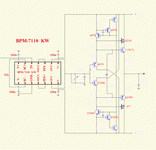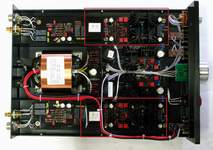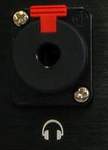|
About ACSS:
ACSS (Audio-gd Current
Signal System) is Audio-gd's system for transmitting audio signals in
the current domain. This concept, first seen in 1966, we have used for
many years, and since 2006, have evolved the technology to include all
audio signals in our systems from the digital source to the power
amplifier. Since 2005, ACSS comp5nts have become Audio-gd's most popular
products. |
|
The C-2.1 functions:
Front
plate:
Volume knob: Control the volume
level of the headphone/pre amp.
Gain
button: Push in for high gain (+13DB), out for low gain
(+4DB). Only available while using RCA input. ACSS input is always set
at High gain regardless of the Gain button for the best sound level.
Pre
button: Push in for
preamp output, out for
headphone output.
Selector
knob: Select input signal
between 1(RCA) and 2(RCA) and 3(ACSS)
Design Features:
The C-2.1 applied the ACSS is a non-feedback
technology made with fully discrete amplifiers. Most people know the
global
feedback design can offer better specs in test measurements, and
non-feedback can't do well in test measurements but can offer better
sound for the human's ears. Here is a conflict of the classic circuits.
But the ACSS opens a new field, it can offer a least coloration sound
which is more neutral with very low distortion and high linearity. So
it can retain the dynamics, detail and neutral sound but not sound
bright or harsh.
The output buffers are
Non-feedback. For low impedance, we applied a diamond output stage
(the MOSFET and transistor combined the
Cascode
stage )which is quite less colored than most conventional circuits.
ACSS non-feedback amp
ALPS 27 volume pot
Neutrik socket




C-2.1 applies the
excellent analog output stages, but these are not the only keys of
the best sound. The power supply is most important. Even applying
the best amp designed , if matched to a normal power supply, the
total sound may still be average or sound musical but can't be
neutral and detailed.
C-2.1 applied two
groups of
The class A parallel connection PSU for the ACSS analog output stages.
The
class A parallel connection PSU has very high input impedance for avoid pulse through the PSU from affecting the DAC and low
output impedance with very fast speed and high linear , so it is a very clean
power supply. In my experience, its sound is better than battery power
supply, better human sound and neutral.
Class A power supply.


C-2.1 has three pairs of inputs: one set of
ACSS current mode input, and two single-ended RCAs inputs. If the input
signals are coming from RCAs, they are internally converted into
current signals and then amplified. To use the C-2.1 as a preamplifier,
there is one set of RCA output for your power amp connection.
In order to minimize interference and distortion of sound
quality, the left and right channel circuitries are completely
separated.
C-2.1 uses an all aluminum alloy chassis to
prevent the eddy current of the transformer from interfering with the
circuit board.
About volume in ACSS circuits:
C-2.1 use ACSS technology, which is very different
from conventional technology.
In conventional technology the gain is fixed, like 3DB or 6DB.
ACSS circuits in fact have 0DB gain and are fully
non-feedback, so it is a completely different circuit.
In ACSS
technology the "gain" changes with volume, and while you turn off the
volume, the "gain" is -80DB (in conventional technology it can't work
lower than 0DB).
While you are listening in normal
volume, the "gain" may be around -50DB, or between -80 to +13DB.
The volume control is also
different from conventional technology. Conventional technology volume
control is placed at the input, and attenuates the signal.
But in ACSS, it is placed at the
ACSS modules output, where the output is the current signal, not the
voltage signal. The volume control is I/V conversion, and the volume
depends on the current (I) conversion to voltage (V). (Like D/A chips
output I/V conversion)
The sound quality benefits
from I/V conversion volume control. Mark Levinson also knows that
current volume control has great benefits, so in their Top End preamp
NO.32 volume control, they use many components to change the signal to
become current signal (I), then through the R-2R network to control the
volume, and then changed back to voltage signal (V) again. But C-2.1
is simply a more complete work in terms of the current signal, and
technically, it is superior to conventional technology.
ก@ |

